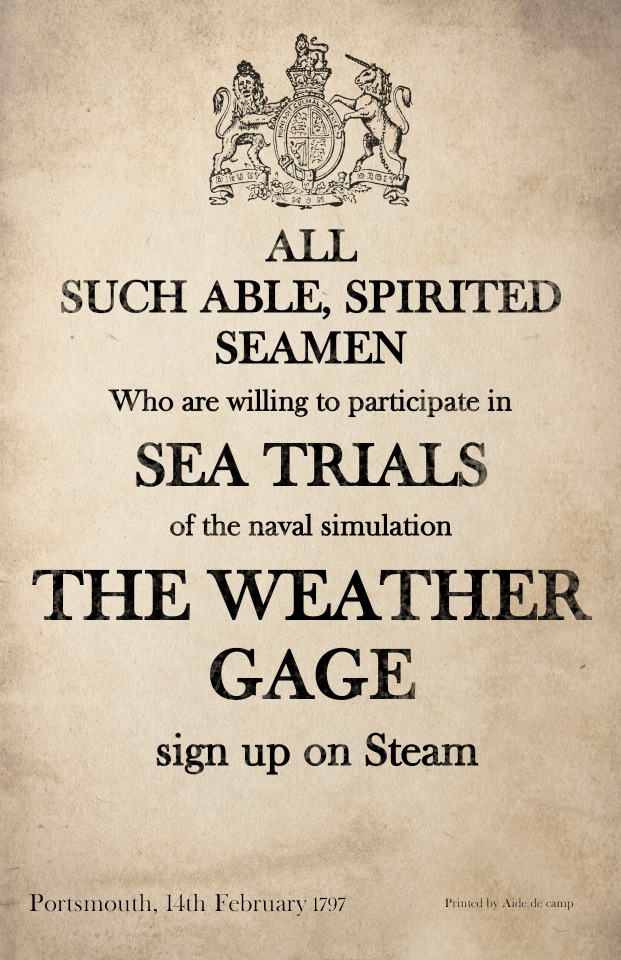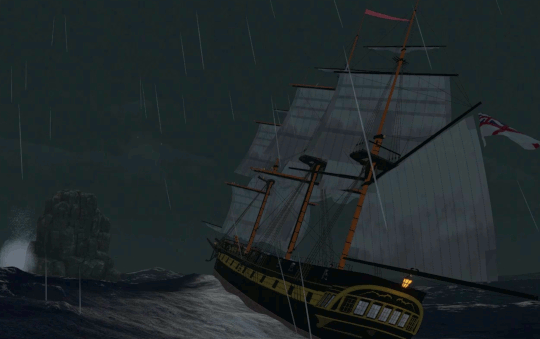Always interested in history (Age of sail, Napoleonic Wars, Arctic exploration, Naval history). Developing a naval simulation called "The Weather Gage" and searching for naval/historical inspiration in tumblr
Don't wanna be here? Send us removal request.
Text

Poster to announce the possibility to sign up to the playtest (or "Sea trials") of the simulation "The Weather Gage" (see it above)
It was inspired by an original recruiting poster of the time (see it below)

6 notes
·
View notes
Text
youtube
Full video of HMS Surprise sailing in stormy weather from Ushant to Eddystone rocks, SSW off Plymouth Sound
All images are gameplay of "The Weather Gage" naval simulation (with some time & weather manipulation at the end)
0 notes
Text
Christmas at sea - The Longest Johns (based on a poem by Robert Louis Stevenson)
youtube
When working on a naval/sailing simulation it's helpful to have some musical inspiration to have the proper mood. Perfect for the Christmas time is this song by the Longest Johns, based on a poem by Robert Louis Stevenson. Very interesting description of the sailing maneuvers and how sailors would feel in such a dangerous situation
Christmas at Sea
The sheets were frozen hard, and they cut the naked hand; The decks were like a slide, where a seaman scarce could stand; The wind was a nor'-wester, blowing squally off the sea; And cliffs and spouting breakers were the only things a-lee.
They heard the suff a-roaring before the break of day; But 'twas only with the peep of light we saw how ill we lay. We tumbled every hand on deck instanter, with a shout, And we gave her the maintops'l, and stood by to go about.
All day we tacked and tacked between the South Head and the North; All day we hauled the frozen sheets, and got no further forth; All day as cold as charity, in bitter pain and dread, For very life and nature we tacked from head to head.
We gave the South a wider berth, for there the tide-race roared; But every tack we made we brought the North Head close aboard. So's we saw the cliff and houses and the breakers running high, And the coastguard in his garden, with his glass against his eye.
The frost was on the village roofs as white as ocean foam; The good red fires were burning bright in every longshore home; The windows sparkled clear, and the chimneys volleyed out; And I vow we sniffed the victuals as the vessel went about.
The bells upon the church were rung with a mighty jovial cheer; For it's just that I should tell you how (of all days in the year) This day of our adversity was blessèd Christmas morn, And the house above the coastguard's was the house where I was born.
O well I saw the pleasant room, the pleasant faces there, My mother's silver spectacles, my father's silver hair; And well I saw the firelight, like a flight of homely elves, Go dancing round the china plates that stand upon the shelves.
And well I knew the talk they had, the talk that was of me, Of the shadow on the household and the son that went to sea; And O the wicked fool I seemed, in every kind of way, To be here and hauling frozen ropes on blessèd Christmas Day.
They lit the high sea-light, and the dark began to fall. "All hands to loose topgallant sails," I heard the captain call. "By the Lord, she'll never stand it," our first mate, Jackson, cried. . . . ."It's the one way or the other, Mr. Jackson," he replied.
She staggered to her bearings, but the sails were new and good, And the ship smelt up to windward just as though she understood; As the winter's day was ending, in the entry of the night, We cleared the weary headland, and passed below the light.
And they heaved a mighty breath, every soul on board but me, As they saw her nose again pointing handsome out to sea; But all that I could think of, in the darkness and the cold, Was just that I was leaving home and my folks were growing old.
Robert Louis Stevenson
8 notes
·
View notes
Text
Smeaton lighthouse on the Eddystone Rocks

Smeaton's lighthouse on the Eddystone Rocks, SSW off Plymouth Sound, as modelled in "The Weather Gage" simulation. The naval simulation takes place during the French Revolutionary Wars and the Napoleonic Wars. During that period the Smeaton Lighthouse was located on the Eddystone Rocks. In 1882, the upper part of Smeaton's Lighthouse was dismantled and rebuilt as a memorial to Smeaton on a new base on Plymouth Hoe
The HMS Surprise model is sailing in the background for scale comparison purpose (probably such a ship would not sail that close to these rocks in real life)
Below the plan of Smeaton's Lighthouse used as a reference to create the 3D modell

2 notes
·
View notes
Video
A very good explanation for the "weather gage" as a naval tactic. I hope this helps understand why my naval simulation is called "The Weather Gage" ;)
As Stephen Maturin asked : What is the Weather gage?
In most accounts of anval battles during the age of sail, a lot of emphasis seems to be placed on one side or other having the weather gage (or gauge). It was crucial importance, as the ship or fleet with the weather gage had the ability to break off the fight, or to dictate the pace of the action.
Essentially, a ship or a fleet which is to windward of the enemy is deemed to have “ the weather gage”. Windward, of course, is the side from which the wind blows; the other ship or fleet- without is deemed to be leeward. The ship or fleet to leeward is sometimes described as having “ the leeward gage”. During an engagement, the side without the weather gage would find it far harder to come to grips with the enemy than the fleet to windward of them. They would have to tack slowly towards the enemy, all the time exposing themselves to gunfire. The fleet with the weather gage could also move further to windward, and so keep its distance, and thereby avoid battle. It would also find it relatively easy to close with the enemy, as all it had to do was to sail downwind.
One final advantage was that if two sailing ships were parallel to each other, and one had the weather gage, then both ships would heel over slightly, but the one to leeward would have its guns pointing upwards at the opposing fleet, while the guns of the ships windwards would point down at the enemy.This made it far harder for the leeward ship to depress its guns far enough to fire into the hull of the enemy. By contrast, the ship with the weather gage would find it comparativley easy to fire at the enemy’s hull.
232 notes
·
View notes
Text
Sailing in stormy weather

HMS Surprise model in the naval simulation The Weather Gage
The sailing started near the Phare du Stiff (lighthouse) in Ushant and ended at Eddystone lighthouse and rocks, SSW off Plymouth Sound (state of 18th century / Smeaton's lighthouse ... currently the lighthouse is on land: Eddystone Lighthouse - Wikipedia)
Should post a picture of Eddystone lighthouse model some time later
#hms surprise#age of sail#sailing ship#napoleonic wars#simulation games#frigate#tall ship#warship#royal navy
6 notes
·
View notes
Text

Broadside by HMS Surprise in "The Weather Gage"
#hms surprise#sailing ship#age of sail#napoleonic wars#simulation games#frigate#french revolutionary wars#warship
1 note
·
View note
Text
HMS Surprise 3D Model

This is a model of the HMS Surprise for the naval simulation "The Weather Gage"
It is based on the real friagte HMS Surprise (former Unité) and not the "movie Surprise" from "Master & Commander"

References for the 3D modelling are the Admiralty plans (see above), the plans from the book "The Frigate Surprise" by Brian Lavery, some of Geoff Hunt's paintings and plans of similar ships (e.g. "La Tourtelle" a sister ship)
#sailing ship#tall ship#hms surprise#napoleonic wars#simulation games#3d model#royal navy#frigate#age of sail#french revolutionary wars
2 notes
·
View notes